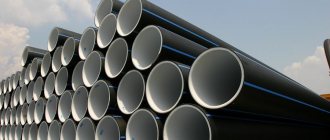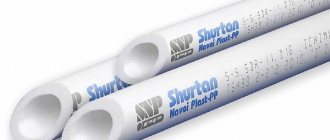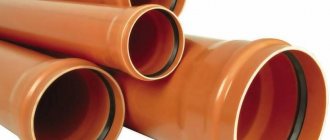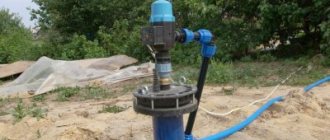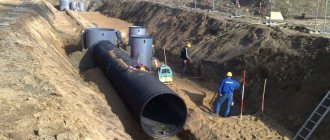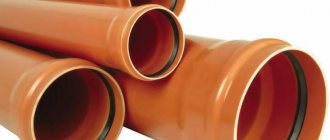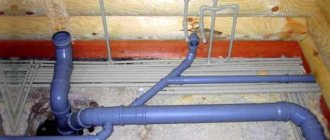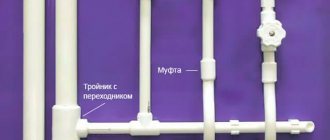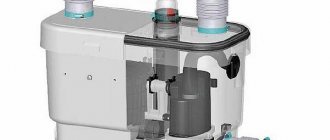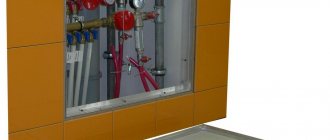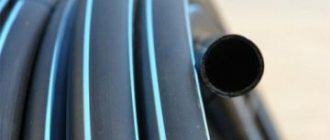Connection using electrofusion welding
For this method of connecting pipes, it is necessary to use shaped elements with electric spirals mounted inside. This coupling is put on the pipes, the spirals begin to heat up and melt the polyethylene, which is then tightly soldered. This pipe connection is quite reliable and is used when installing sections whose diameter is less than 160 mm or in cases where it is quite difficult to get to the joining point. In this case, you need to take into account that the cross-section of the pipes being joined should not differ by more than 10%.
If you want to connect pipes in this way, you need to clean the edges of the pipes from dirt and align them. During operation, it is advisable to securely fix the product using a positioner. After that, the two ends of the pipe are installed in the coupling and the welding machine is turned on. All data, such as soldering time and temperature, can usually be seen on the part's barcode.
How to weld pipes using an electric coupling, see below:
How to install a water pipeline yourself
The work algorithm depends on the water supply project. If you have the skills and technical capabilities, the installation of a capital pipeline takes place on a turnkey basis: from digging a well to connecting pipes to taps in the house.
We recommend that you read: How to make a bed frame from a profile pipe with your own hands
Installation tools
To install the pipeline, provided the well is ready, the following is required:
- shovel for digging trenches;
- adjustable and gas wrench;
- apparatus for welding pipes (“iron”);
- pipe cutter or scissors;
- tape measure (centimeter).
For electrical installation work, you will need instrumentation (testers, voltmeters), pliers, screwdrivers, wire cutters and other tools depending on the scope of work.
Scope and characteristics of HDPE pipes
The material from which such pipes are made is dense, high-quality polyethylene, thanks to which the products are quite durable and flexible. Unlike heavy metal pipes, HDPE pipes are lightweight, which makes them easy to install yourself, without outside help. These pipes also do not need cathode coating, unlike the same metal products. It’s also nice that they don’t require any special maintenance. Let's look at their main advantages:
- Pipes are resistant to many chemical compounds and aggressive environments: acids, alkalis.
- Corrosion does not threaten products made of polyethylene at all, and they do not need to be insulated.
- If the water inside the pipes freezes and begins to expand, they will not be damaged, since the material is strong enough and resistant to mechanical stress. The size of the pipes can increase by 5–7% from the original state, and then return to its original position without loss of properties.
- Excellent water hammer tolerance.
- They are not afraid of rotting, bacteria and fungi that can affect various materials.
- They are quite elastic, which allows them to be used in seismically hazardous areas. What's impressive is that they break when extended to six times!
- Relatively low cost.
- Light weight and convenient and cheap transportation, which will cost 2 or 3 times less than transportation of heavy metal pipes.
- Easy to operate, assemble and install pipes yourself, all this can be done without the help of experts.
- The service life of HDPE pipes is more than 50 years.
- Polyethylene is a dielectric material, i.e. does not conduct electric current, which means that pipes made from it do not conduct current either.
- Unlike metal pipes, during operation the pipes do not accumulate silt and scale on the walls, and condensation rarely forms on their surface.
The only point to note is that the material begins to soften when the temperature reaches 80˚C. Therefore, the use of hot water pipes is not recommended. But they have found their application in the following areas:
- sewerage device;
- cold water plumbing;
- protection of electrical high-voltage wires from water and other external factors.
There are two types of low pressure polyethylene pipes:
- Pressure pipes – for water systems and gas pipelines.
- Non-pressure pipes - for storm drains and sewage systems.
If we talk about the wall thickness of HDPE pipes, it can vary from 2 mm to 72 mm. Their diameter also varies – from 20 mm to 1200 mm. The size of the product is selected depending on where the pipes will be used and what their purpose is. If you need to provide water supply in your house or country house, then the ideal option would be pipes whose cross-section varies from 20 mm to 30 mm, and they can be connected using plastic or compression brass fittings. When you need to lay a sewer system, the suitable pipes for you will be products with a diameter from 90 mm to 160 mm. It is advisable to fasten them with couplings, complementing the O-rings.
In order to correctly install HDPE pipes, it is important to know how they need to be connected to each other. Depending on the diameter and size, there are three different methods for connecting pipes:
- Butt welding is a one-piece type of installation carried out using a special apparatus.
- Connection using electrofusion welding.
- Connection through fittings and flanges is a dismountable method of pipe installation.
Let's look at what each connection method is, how it is done, and why one or another method is used.
Advantages and disadvantages of polyethylene pipes
Firstly, the cost of a linear meter of polyethylene water pipe with a diameter of 25 mm is only 30 cents; for comparison, a meter of polypropylene pipe will cost at least 1.5 dollars. Even taking into account the fact that couplings for polyethylene and polypropylene cost 2.2 dollars and 1.3 dollars respectively, the use of polyethylene pipelines will cost much less than plastic pipelines based on polypropylene.
Moreover, polyethylene, as a rule, is sold in the form of coiled sections of 20 and 100 m. Polypropylene pipes are sold in retail in ready-made pieces of 4 m and 6 m, which means that the number of couplings will be required several times more.
Secondly, polyethylene pipes have good resistance to solar ultraviolet radiation, high strength and ductility. Even at low temperatures and frozen water inside the water supply, plastic pipes do not fail.
Two grades of polyethylene pipes are produced for plumbing systems:
- LDPE is a high-pressure polymer, used for small sections of water pipelines where good flexibility and strength are required;
- HDPE is a low-pressure polymer, used for high-pressure water pipelines and highways.
For your information! Country water pipelines are built from polyethylene pipes designed for transporting drinking water.
They are easily distinguished by their blue or white longitudinal stripe on a black background. Any other brands, for example, with a yellow or orange stripe, are designed for transporting gas and liquid chemical products, so they are not even suitable for watering in a summer cottage. On the surface of the plastic pipe, the purpose, diameter, wall thickness and GOST, on the basis of which the plastic product is manufactured, must be indicated.
In addition to the brand of polyethylene and purpose, plastic pipes are distinguished by operating pressure:
- Low-pressure or L-class, the working pressure in the line is no more than 2.5 atm;
- Medium-pressure S and SL, designed for pressure from 4 to 8 atm;
- High-pressure T-class, used for water pipelines with a working pressure of more than 10 atm.
The latter are used for equipping wells and boreholes in summer cottages; class L and SL are most often used for water supply distribution throughout the territory, provided that the terrain has a difference of no more than 10 m in height for every 100 m of horizontal length.
Plumbing assembly
HDPE water pipelines can be assembled in two ways:
- Using compression fittings - in this case no special equipment is needed.
- With help - for this you will need a special soldering iron, which is used for installing a polypropylene pipeline.
It must be said that there are two more ways to connect this material - butt welding and using an electric coupling. However, they are not used for self-installation, as they require special skills, so we will not consider them.
Assembly using compression fittings
The use of compression (collet) fittings is the most common method of installing small-diameter polyethylene pipes (up to 110 millimeters). In other words, when installing household water pipes, this is the assembly method that is usually used.
Instructions for or other fittings are as follows:
- First of all, you need to carefully cut the pipe so that the cut is perpendicular to its axis. Ideally, this work should be done using a special pipe cutter.
- After this, you need to eliminate burrs and other irregularities.
- Next, you need to remove a chamfer two to three millimeters wide from the edge to form a cone.
- After this, you need to put the compression connection elements on the pipe in this order:
- Clamp nut;
A clamping ring, also called a collet;
- Retaining ring;
- And lastly, the o-ring is put on the edge of the chamfer.
- Then the end of the pipe that will be immersed in the fitting must be lubricated with plumber's grease.
- Next, the pipe is inserted into the fitting pipe, after which the clamping nut is screwed on.
All other water supply connections are installed in the same way. After introducing water into the system, you should make sure that all connections are tight. If necessary, they should be tightened slightly.
Diffuse welding
HDPE water supply using diffuse welding is assembled quite simply:
First of all, the device must be warmed up to operating temperature. To do this, you need to plug it into the outlet and wait until the green indicator lights up.
- Then the parts to be connected are inserted into the heated nozzles. They need to be held in this position until the plastic melts. The exact time is indicated in the table that comes with the soldering iron.
- After this, the parts are pulled out of the nozzles and connected. In this position, without moving or turning, they need to be held until the molten polyethylene completely hardens.
All pipeline elements are installed according to this scheme. After completing the work, as in the previous case, you need to test the system.
The benefits of water supply from HDPE pipes
In contrast to other materials (cast iron, steel, asbestos), HDPE water supply is significantly superior to them in the following indicators:
- guaranteed service life is 50 years;
- products with a diameter of 20-110 mm, offered in 1000 meter coils, speed up the pipeline laying process and save money on consumables;
- the use of thermistors in connecting fittings speeds up work and simplifies the joining process;
- It is easier to learn to work with polyethylene than with metal products.
They can be disassembled and reassembled many times with minor losses. It is possible to extend the old pipeline inside the structure.
Physical and chemical properties
The use of polyethylene water supply is considered the right decision due to the positive consumer qualities of this material. These include:
- it is not susceptible to corrosion and is capable of transporting water and more aggressive liquids;
- has less weight than traditional materials, which simplifies the work of loading and transporting it;
- has the ability to expand up to 7.5%, thanks to this elasticity it can easily withstand earthquakes and minor ground movements;
- the smoothness of the inner surface enhances throughput;
- the low elasticity of the material significantly reduces the potential for possible water shock hazards and increases resistance to freezing.
The smaller diameter of the HDPE pipe for water supply is equivalent in throughput to the larger diameter of the product made from traditional material.
Rating of types of water pipes
Galvanized
This is the oldest type of pipe; they are assembled with threaded connections that must be sealed with special materials. To make such connections, you need to study and practice for some time. Galvanized pipes are not very pretty. They become overgrown with rust and salts from the inside. Their reliable service life does not exceed 25 years. Galvanized pipes are very dangerous to use together with non-ferrous metal parts. With such a set of qualities, these pipes are not at all cheaper than more modern ones, and taking into account thread cutting, they can be even more expensive. I would not recommend using galvanized pipes in plumbing.
Metal-plastic
These pipes have a plastic inner layer, making their service life more than twice as long as galvanized pipes. Metal-plastic pipes have thin walls and, accordingly, a small outer diameter. Assembled using collets. This is not a very reliable type of connection, but it is quite simple, and even a beginner can master it. Practice has shown that over time, collet clamps can leak, and the pipe itself loses elasticity, which makes repairs difficult. When installing such a pipe, it is necessary to leave space for thermal expansion of the pipe. Reliability greatly depends on its quality, and quality depends on the manufacturer. Push-in connections are very expensive and have to be saved.
Polypropylene
The water supply from such pipes is very reliable; it can be safely hidden behind wall cladding. Pipes are assembled only by soldering, which requires special but inexpensive equipment. The soldering process is very simple and reliable.
The pipes themselves and especially the fittings are quite cheap. Our country is one of the world's leading producers of polypropylene, and on the market you can find a large range of domestic products of excellent quality.
Polypropylene pipes have thick walls (5 mm or more), which determines the large outer diameter of the pipe. This quality prevents the hot water in them from cooling quickly.
Polypropylene pipes expand significantly when heated and can sag.
Contrary to popular myth, such pipes also freeze and burst in the cold. They are intended for residential use only.
Copper
Such pipes can be assembled either on collets or by soldering. Assembling collets is very difficult, because it requires both skill and equipment. Soldering requires only a gas torch, a wire brush, flux and solder. You can learn soldering in half an hour of work.
Copper pipes do not become overgrown with rust, have the smallest outer diameter of those considered, slightly elongate when heated, and do not create much noise. Water supply from such pipes is very reliable and can last for more than 50 years.
Copper pipes for soldering are the undoubted favorite of our rating. In contrast to its exceptional advantages, you can indicate a very high price for both the pipes themselves and the fittings.
Water with increased hardness or iron content reduces the reliability of the water supply system, so it is advisable to use dirt filters. No type of pipe should be left with water in the winter. Information that a certain type of pipe does not crack and can withstand prolonged and severe frost is a myth.
Continued.. Country water supply. How to choose a boiler?
Which pipes to choose for country water supply?, 4.0 out of 5 based on 1 rating
Materials for polypropylene water supply in a summer cottage
The reason for this popularity is the very simple and reliable soldering system of polypropylene; with a little practice, not only long pipeline branches can be made from plastic pipes, but also greenhouses, hotbeds, frames of tents and canopies.
In addition to the high price of the material, polypropylene has several significant disadvantages that you should know about before planning the construction of a water supply system at your summer cottage:
- If polypropylene pipes are filled with water, then freezing, as a rule, leads to the appearance of hidden cracks and destruction of the line;
- Under the influence of solar ultraviolet radiation, the process of secondary polymerization begins in polypropylene. Over time, the material begins to crumble and lose strength, even if the pipeline is not exposed to direct sunlight.
Some brands of polypropylene pipes can be used for street water supply. As a rule, manufacturers paint plastic in black and green colors; polypropylene for internal installation is light gray, white or beige.
For the main supply line of the pipeline, you can use a pipe measuring 32x3 mm; this will be enough to lay out the water supply and organize irrigation on 5-6 acres of a summer cottage. Branches and outlets are made with 16x2 mm pipes with the installation of taps.
Shut-off and switching valves need to be given special attention. Traditionally, for plastic water supply systems, most supplying companies suggest using polypropylene taps with a rubber mushroom that blocks the flow hole.
Such designs are usually used as shut-off valves in domestic water supply systems. They are not suitable for country water supply; even with regular maintenance, such valves and taps quickly fail. Their main advantage is ease of installation; they can be soldered into a plastic line, like a regular coupling.
A more rational solution would be to use conventional bronze valves; their service life is 10-15 years or more. The only inconvenience is that to install such a crane you will have to additionally purchase two metal-to-plastic adapters.
Installation of water supply at the dacha
It is most advisable to use polyethylene pipes for low-pressure irrigation with a diameter of 20.0 - 40.0 mm and a wall thickness of up to 2.0 mm. For branch branches, products with a diameter of 25.0 mm will be sufficient. Such pipes fully cope with their task and will not require replacement for a long time. They are also able to withstand mechanical loads, even such as being hit by garden equipment.
Compression fittings for connecting PE pipes
Laying your own garden water supply from polyethylene pipes is quite simple. The only tool you need to prepare is an adjustable wrench. The connection of pipe products will be carried out using compression fittings; they are the most practical and effective for dacha conditions.
The pipeline is laid in several stages:
- First, as with the installation of any other water supply system, a detailed layout diagram is drawn up, including the future irrigation system. It allows you to more accurately navigate the quantity of pipe products and compression fittings.
- There are two methods used to lay the pipeline:
- open on the ground surface. With this method, the installation and dismantling of PE pipes is greatly facilitated, but at the same time the likelihood of damage to the products increases;
- at a shallow depth in the ground. In this case, the HDPE pipe for the dacha is more protected, and dismantling it will not be difficult.
Laying PE pipes on the ground
- The second method is preferable. The main HDPE pipe at the dacha is laid in the ground. In this case, you don’t have to worry about accidental damage.
- The branches can be laid along the ground, or even better, mounted on special holders for more convenient connection to sprinkler devices.
When laying the pipeline, it is necessary to ensure a slight slope of the system in order to drain water from the pipes at the end of the season. To do this, it is enough to mount a regular valve at the lowest point of the main line.
- It is recommended to install valves at branch points. Then you can precisely control the supply of water exactly to the right places in your summer cottage.
Buried pipeline installation
- Buried pipeline laying.
- The required pipe sections must be securely connected using compression fittings.
- To connect, the ends of the products must be cleaned of dirt and it is advisable to remove the end chamfer. Unscrew the union nut of the fitting a couple of turns.
- On the pipe itself, mark the depth to which the coupling should enter the pipe.
- Applying a certain force, the fitting is inserted into the pipe and the union nut is tightened.
When tightening fittings, ensure that the nut is tightened to the recommended torque. Otherwise, if the tightening is insufficient, the tightness of the connection is not guaranteed. If you apply more force than normal, there is a possibility of damaging the pipe.
We can conclude that a self-installed country water supply system from HDPE pipes is an effective way to ensure water supply to a country house for domestic needs, as well as to organize a practical and reliable watering system for a summer cottage, while you can significantly save money and time.
How much does it cost to make a water pipe from HDPE yourself?
Approximate cost of water supply ( estimated prices for 2015 ) as in the picture above:
7 compression fittings ~ 700 rubles (~ 100 rubles/piece)
2 taps ~400 rubles (~200 rubles/piece)
Pipe ~ 750 rubles for a BAY (!) 25 meters (~ 30 rubles/meter)
Pipe fasteners ~40 rubles (~10 rubles/piece)
TOTAL the water supply cost 1,890 rubles instead of 30,000!!! (for 25 meters of pipe)
I gave myself a couple of days to work and quickly began to figure out the technology for installing water supply on the site. There are not many of these technologies. In fact, as I found out, only one technology for laying water pipes is widely used - HDPE pipes. That's why I decided to use these same pipes for water supply. At any base you will see such pipes in coils. The pipes are quite light and compact when rolled up. There will be no problems with delivery.
A simple diagram of a water supply system in a country house
Advantages of working with polypropylene pipes.
With the emergence of the possibility of installing water pipes using polypropylene products, steel pipes faded into the background. Polypropylene products are not at risk of rust, and their service life is almost 50 years. Polypropylene pipes in no way affect the chemical composition of water, and the installation of these pipes is quite simple.
What to take into account when choosing equipment for water supply and installation of this station.
Based on the daily volume of water consumption and the initial conditions of an independent source, a water supply station is selected. The decision about the installation location of the equipment is influenced by the distance from the house to the well or borehole. Installation of the station is also possible in the building itself, if the distance is short. If the water source is at a significant distance from the house, it will be necessary to install the station on the street, having previously insulated the equipment in order to maintain functionality even in cold weather.
Why is it necessary to install filters and a diagram to build a water supply system in a country house?
Filters installed in the well not only protect the permanent water supply from early wear, but also deeply clean the water entering the house through the pipeline. In addition, the water becomes drinkable.
As soon as the filters are installed, they begin checking at their connection points. After which the entire system is checked. If the checks are successfully completed, then you can use this water supply on an ongoing basis.
To ensure year-round water supply to your home, a simple water supply structure diagram is suitable. This is the best option with minimal investment. The bottom line is that when the water supply system operates during the cold season, through a small gap located in the reserve drain, the water entering the pit is absorbed into the soil. Thanks to this simple combination, water in cold weather is protected from freezing in the pipeline. In the summer, the winter valve simply needs to be kept open.
This water supply structure allows you to supply water to a country house throughout the year, but there is one drawback - there will always be humidity in the pit.
We will be glad if, thanks to this article, you learned how to install a water supply system in your dacha yourself. If you do not want to do this or are not sure that you will be satisfied with the results obtained, you can always turn to specialists for help. In any case, installing a permanent water supply will ensure the availability of water in your country house for several decades.
Do-it-yourself installation of a country water supply system
The main difference between a country water supply system and a home circuit is that pipe routing must be carried out taking into account the following requirements:
- Large length of water mains on the territory of the summer cottage;
- For every 5-7 m of the length of the underground water supply, it is necessary to solder in an outlet with a tap.
The water pipeline must be laid in the ground to a depth of at least 40-45 cm with a protective layer of slate scraps, fragments of plaster stone or old asbestos-cement pipes.
For your information! Laying a plastic pipe allows you to protect the pipe from accidental damage by a shovel, cutting blade of a walk-behind tractor or tractor.
Most summer residents are well aware of the effect of plastic pipes rising in the ground. Over time, due to the washing off of the top layer and heaving of the soil, the lightweight plastic pipe is gradually squeezed out to the surface, so laying protection makes it possible to combat the deformation of the water supply system.
It is clear that water supply pipes can be laid simply on the surface of the ground, but in summer cottages this installation method is used extremely limitedly for two reasons. Firstly, this interferes with the processing of the beds, and secondly, prefabricated structures made of polyethylene pipes are quite easily damaged by being caught by a tool or touched by the wheel of a walk-behind tractor.
One of the most important characteristics of a plastic water supply is its strength and rigidity, which become the main obstacle when installing an irrigation system. Rigid material can only be bent at a large radius, so compression couplings have to be used for joining and turning.
Essentially, a coupling or fitting is two parts connected into one body using threads. To splice two lines of water supply, it is enough to install the halves on the ends of the pipes, lay the seal and close the fitting with force. It is clear that this connection method is not designed for radial load, therefore, if you step on the plastic coupling, it is quite possible that the fitting will have to be disassembled and spliced in a new way.
In the same way, you can connect a flexible hose, build a turn in the line at a right angle, or make a branch into several threads of smaller diameter.
Installation of the irrigation outlet is relatively simple. To do this, install a clamp with a coupling on the pipe for installing a vertical outlet; after tightening the bolt fastening, you need to drill a hole and screw in a tap with a nozzle under the hose.
Choosing material
As already mentioned, water supply and sewerage in a dacha are most often installed from what is at hand.
A study of existing sewerage structures made it possible to determine the main types of pipes used in country house construction:
Steel pipes for sewerage
- Steel pipes - this material is often left over after the installation of other communications or building structures; it can be purchased at scrap metal collection points at its residual value. But, before installing a sewer system in your dacha using such pipes, you should also become familiar with the disadvantages of this material. Firstly, finding material of a suitable diameter is quite difficult.
- Thirdly, steel pipes are highly susceptible to corrosion; a significant layer of various deposits forms on their inner surface, so such a pipeline has to be cleaned quite often.
Secondly, installing a line from such pipes requires welding work, which leads to the need to hire professional performers.
That is why you should use steel pipes only if you have a surplus of this material and you do not know where to use it.
Sewerage made of cast iron pipes
- Traditionally, the installation of pipes in the country (for sewerage) was carried out using cast iron. Such pipes withstand the effects of groundwater well, they are more resistant to corrosion (compared to steel), and are highly durable. To reduce flow resistance, such pipes can be coated with bitumen compounds, due to which the amount of deposits on the internal walls is significantly reduced. The disadvantages of cast iron pipes are also traditional - heavy weight, complex installation (the need for embossing), in addition, cast iron is difficult to process, so cutting it can be significantly difficult.
- PVC sewer pipes are considered the best option today. The bell-shaped design using rubber seals makes installation very simple; even a person without construction skills can handle it. Working with this material will allow you not to think about how to lay pipes in your dacha for sewerage. Plastic is easy to cut, and the presence of a variety of fittings allows you to mount a line of even complex configurations. PVC does not rot, is not susceptible to corrosion, and the service life of such pipes is practically unlimited (subject to the installation technology). Another advantage of plastic is its low flow resistance, which eliminates the amount of deposits inside the pipeline.
If we talk about the cost of the material, then plastic pipes are rightfully considered one of the most profitable options, and there is a real opportunity to save on installation, which can be done independently.
Which pipes to choose is, of course, up to you.
Types of garden aqueduct
There are two ways to lay a pipeline at a dacha - summer and seasonal (major). Each of them has its own advantages and disadvantages.
Summer option
The method of ground installation of a water supply system in summer cottages is used to organize watering of vegetable beds, berry bushes, and fruit trees. Ground water supply is used for supply to a bathhouse, summer kitchen, and garden house.
The seasonal water supply system is a ground loop with pull-in fittings at the branch point. If the site is used exclusively during the warm season, it is reasonable to lay pipes on the surface. Such a system can be easily disassembled for the winter to prevent theft of materials during the off-season.
On a note! To avoid damage to communications by agricultural equipment, summer water supply is laid on special supports.
The main convenience of a seasonal polyethylene water supply is its mobility. If necessary, the configuration can be changed in 10-15 minutes. It is enough to add or remove a few meters of pipe or run it in a different direction.
Irrigation system
Scheme
Temporary summer water supply at the dacha from HDPE pipes is assembled and disassembled with your own hands according to the principle of a children's construction set.
Typical diagram of a country water supply system
The network diagram is drawn up in relation to the detailed site plan. The drawing marks the location of green spaces, water intake points, a house, a shower, and a washbasin.
Important! Pipes are laid with a slope towards the water intake point. A drain valve is installed at the lowest point of the system
Capital system
If the site is thoroughly developed and used all year round, it is reasonable to spend time and money on installing a capital water supply system. The principle of connecting elements in this case does not change. The difference lies in the additional installation of compressor equipment and the closed arrangement. To install a permanent water supply system, communications are laid in trenches below the freezing depth of the soil.
Inserting HDPE pipes into the house
Insulation
The depth of soil freezing in different regions of the Russian Federation differs significantly. To avoid rupture of communications during sudden temperature changes, it is recommended to insulate them.
To insulate the capital water supply system from HDPE at a summer cottage, the following materials are used:
- Basalt insulation in the form of ready-made cylindrical modules.
- Fiberglass sheet in rolls. You will need to purchase additional roofing material to protect the warm layer from getting wet.
- Expanded polystyrene. Reusable folding modules of two halves, which are used repeatedly, are assembled simply and quickly.
Insulation for pipes made of foamed polyethylene According to statistics, the depth of soil freezing in winter in Russia exceeds 1 meter. For clay and loam in Moscow and the region this is...
On a note! Water under high pressure does not freeze. If a receiver is installed in the system, there is no need for additional thermal insulation of the water supply system.
In capital construction, when laying a pipeline to a shallow depth, a heating cable is laid parallel to the system and connected to a grounded source of electricity.
Defrosting water supply and sewerage pipes Russia is located in a harsh climatic region, so in winter and early spring there is a risk...
How to choose?
Manufacturers offer several types of polyethylene pipes to choose from. First of all, products are distinguished by the type of transported medium.
For the production of gas pipes, special additives are used that change the composition of water. Gas pipes with yellow markings are strictly prohibited for use in the plumbing system!
To assemble the pipeline underground, two types of polyethylene are used:
- HDPE PE 100, manufactured in accordance with GOST 18599-2001. The diameter of the products is 20 to 1200 mm. Such pipes are made black with a longitudinal blue stripe along the entire length.
- HDPE PE PROSAFE, produced in accordance with GOST 18599-2001, TU 2248-012-54432486-2013, PAS 1075. Such pipes have an additional mineral protective shell, 2 mm thick.
For the main line, blanks with a diameter of 40 mm are selected. For secondary - 20 mm or 25 mm.
This is interesting: Rimless toilets - pros and cons, reviews from owners
Which pipes are better
The water supply system for a summer residence can be made of copper. The main advantage of copper structures is their high service life of 70 years. At the same time, copper is highly expensive. Not every person can afford such a water supply.
You can also choose polypropylene pipes for your dacha. Their service life is more than half a century. Their cost is quite affordable. A universal option for water supply in a dacha are stainless steel structures. Their service life is quite long, they can be used for cold and hot water supply systems. The downside, again, is the high cost.
Metal pipes have a long service life. However, they are rarely used when arranging a private home due to a number of disadvantages, in particular:
- Risk of corrosion;
- Risk of deposits;
- During installation you will need a welding machine;
- Insufficient level of environmental friendliness.
A worthy alternative for arranging water supply in a dacha are plastic pipes. Let's consider their advantages:
- Chemical resistance;
- Resistance to corrosion;
- Resistance to deposits;
- Service life more than half a century;
- When transporting hot water, virtually no heat is lost;
- Easy to install.
Plastic pipes are just a general name for many groups of these structures. Which system is better to choose? It all depends on your needs and operating conditions of the system. You can see the variety of these designs in the photo.
It is recommended to use PVC pipes for organizing open wiring, as they have the required rigidity and are also resistant to ultraviolet radiation. When installing them, gluing technology is used.
Polypropylene pipes are universal. They can be used to transport both cold and hot water. With their help, you can also organize a heating system and underground sewerage. Their advantages are the same as those of structures made of cross-linked polyethylene. At the same time, the price of the product is lower. Welding equipment is used during installation. It is worth keeping in mind that when organizing the transportation of hot water, structures with metal or fiberglass reinforcement are used.
Metal-plastic pipes differ in their structure: an outer and an outer polymer layer. The middle layer is made of aluminum. To organize the transportation of cold water, blue or light blue structures are used. If you need to install a hot water supply system, you should choose white structures. Let's consider the advantages of metal-plastic structures:
Corrosion resistance;
- Neat appearance;
- Ease;
- Plastic;
- Long service life;
- Easy to install.
You can also choose PVC pipes. To arrange the transportation of cold water, structures marked PVC are intended, and hot water – CPVC.
Additional recommendations
You can see the entire range of designs for the dacha in the photo. In addition, we have a video on our website with instructions on choosing the right pipes. For the installation of water supply systems, designs from Western brands are usually selected. Manufacturers from Germany, the Czech Republic, and Austria enjoy trust. When purchasing, be sure to check the product certificate.
Features of the selection of plastic pipes for each segment of the water supply system
The simplest conclusion suggests itself: in order to reduce costs, for each section of the country water supply you need to use your own, most suitable brand of plastic pipes.
Four types of plastic pipes and hoses are currently used for country water supply:
- Polypropylene;
- Polyethylene;
- Silicone;
- Polyvinyl chloride.
PVC pipes have good strength characteristics and satisfactory resistance to sun and frost, but it is better not to use it for arranging above-ground water supply systems. In any case, PVC plastic pipes will require special wrapping with polyethylene foam, which protects against accidental scratches and impacts during installation and further use.
For your information! Of the entire range of plastic pipes for country water supply systems, only metal-plastic ones with an aluminum reinforcing layer are not used.
First of all, the price of metal-plastic pipes is several times higher than polymer pipelines made of polyethylene with a similar cross-section.
The metal-plastic pipeline perfectly withstands prolonged heating, high water pressure, and can serve in a summer cottage for several decades. But under one condition - the country water supply must be completely empty of water in winter, and completely filled in summer.
Thin-walled metal-plastic pipes swell when they freeze and the connecting fittings become deformed. In the summer, standing idle without water leads to intense corrosion of the aluminum sublayer; if you step on it or run over it with the wheel of a vehicle, then with a high degree of probability such a country water supply will be damaged.
Connecting pipes using fittings
The simplest and most affordable way to connect HDPE pipes is to connect using fittings. Typically, pipes for water supply and sewerage in city apartments and houses are connected in this way. Typically, the diameter of such pipes is small - 110 mm or less.
If we talk about the previous two methods, their disadvantage is that it is no longer possible to disassemble the welded pipes. They can only be cut. But the connection on the fittings allows you to disassemble the pipe system at any time and replace some parts. Moreover, you can do this more than once, but as many times as you need
It is also important that there is a large assortment of connection elements on the market that have different diameters, and this will allow you to assemble the various necessary branches and wiring in the pipeline system
To assemble a pipeline using fittings, you need to purchase them at the store. They can be plastic or brass compression type. In the same store you need to buy socket plugs that have a flexible seal. Now everything is step by step:
- First, you need to cut the pipes to the desired size, just like when welding. In this case, the ends must be cut clearly perpendicular to the pipe body.
- Now unscrew the union nut located on the fitting by making a few turns.
- Insert the pipe into the fitting until it stops. It should fit into a reinforced rubber seal.
- Then put on the collet, elastic ring and tighten the nut. Small parts can be turned by hand, and when you need to connect pipes with a large cross-section, it is better to use a wrench.
- As always, after installation it is necessary to check the tightness of the connection by filling the pipe with water.
This is how you can easily and without much effort install HDPE pipes using connections through fittings.
Installation
The method of installing the pump depends on its type. A submersible pump (used for source depths greater than 8 m) is suspended on a chain or cable. If the unit is vibrating, you cannot use a metal cable - only a nylon cable.
Installation diagram of a hidden country water supply system
The surface self-priming pump should be installed on a level concrete base. It is necessary to build a canopy for it, or even better, a booth that will protect the unit from rain.
Possible options for arranging a water supply system
It is possible to use a central water supply or pump as a source of water on the site. In this case, an uninterrupted supply of liquid will be ensured by a storage tank or hydraulic accumulator. In a situation with a tank, a supply of moisture is maintained equal to the volume of the container, which can be of any size. It is placed at a height, due to which a slight pressure is created in the water supply.
Using a hydraulic accumulator is more convenient because it maintains stable high pressure in the water supply. By adding a pressure switch and a suitable pump to the accumulator, you can get an automatic pumping station. A hydraulic accumulator is a cylinder-shaped container divided into two volumes by a rubber membrane. In one half there is air under a pressure of about 2 atmospheres, in the other part water is supplied. The hydraulic accumulator has a limited volume, and this is a serious drawback.
When the tap is opened, water comes out of the accumulator, which reduces the pressure in the system, the value of which is controlled by a relay. When the lower threshold is reached, the pump automatically starts and pumps water until the upper pressure level is reached.
